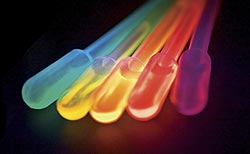Science Wednesday: Science, the Environment & Nanotechnology
Posted on September 17th, 2008 - 10:30 AM Each week we write about the science behind environmental protection. Previous Science Wednesdays.
Each week we write about the science behind environmental protection. Previous Science Wednesdays.
About the author: Nora Savage is an environmental engineer with EPA’s Office of Research and Development. Her focus areas include nanotechnology, pollution prevention, and life cycle approaches for emerging technologies.
I became interested in science after learning about the scientific method: observe, develop a hypothesis, and test—if it holds you have a theory! If not, alter the hypothesis and try again. I used this process when I was a kid to discover that addressing an envelope backwards would get my letter delivered without a stamp. Woodsy Owl (‘Give a hoot, don’t pollute’) showed me the importance of protecting the environment and reducing pollution. The EPA merged these two interests with nanotechnology and a career was born!
 Nanocrystals can have different colors depending on their size. Photo courtesy of Argonne National Laboratory. Nanocrystals can have different colors depending on their size. Photo courtesy of Argonne National Laboratory. |
Nanotechnology is the ability to measure, observe and control at the atomic and sub-atomic level, where new material properties arise that are unlike those of the same material at a larger size. Take gold, for example. The kind used in jewelry is yellow, not very reactive, and melts at 1200°C. At about three nanometers gold is red, very reactive, and melts at 200°C.
How is this related to the environment? First, nanotechnologies can help protect the environment. New nano-compounds and engineered nano-materials can quickly and inexpensively detect and remove pollutants, even very small amounts located in difficult-to-access areas. Utilizing nanotechnology can lead to more efficient manufacturing processes, cutting down on toxic materials used.
We are also aware of the potential for unintended consequences. For example, our use of certain chlorinated compounds to improve aerosol dispersions harmed the ozone layer.
My job is to help tap the potential benefits of nanotechnology while developing a better understanding of the potential trouble they might also bring, and consequently eliminating or minimizing it.
How? By looking at the “life cycles” of new materials and products. By that I mean considering the product from a holistic perspective, including the acquisition of raw material, its manufacture, its use, and eventually its disposal or recycling. My goal is to advance the science that helps determine the exposure potential at each stage, assessing potential hazards, and developing ways to eliminate or reduce them.
Nano Sites:
National Nanotechnology Initiative
The Adventures of Nano
Tags: nanotechnology
| Permalink | TrackBack